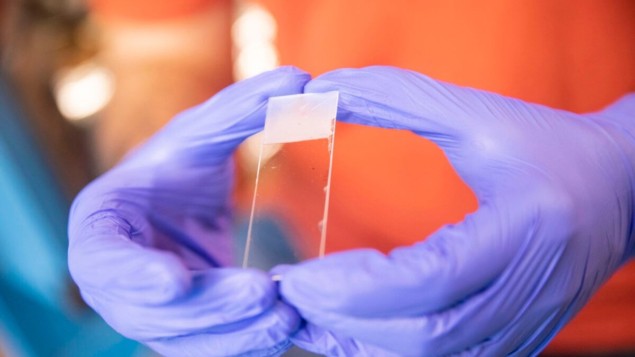
A technique for storing data within mixtures of fluorescent dye molecules that are deposited on an epoxy surface by an inkjet printer has been developed by George Whitesides, Amit Nagarkar and colleagues at Harvard University in the US. The team was able to encode both text and images within patterns of coloured dots. Their approach could offer several advantages over existing molecular storage methods: including higher read and write speeds, and lower costs and complexity.
As our use of digital technology rapidly increases, there is a growing need to rethink the methods we use to store data. In current devices, storage usually involves encoding information within optical or magnetic media – but these technologies often have operational lifetimes of around 20 years and require substantial amounts of power to maintain.
Recently, researchers have begun to explore the possibility of storing information in single molecules, such as DNA. In principle, this would allow for high density data storage that would require no power to maintain and could potentially remain stable for thousands of years. However, the scalability of the approach is limited by high costs and complexity, as well as slow read and write speeds.
Tiny dots of dye
In their study, Whitesides’ team developed an alternative technique, in which they encoded information in tiny dots of fluorescent dye deposited on an epoxy surface using an inkjet printer. Each dot can contain up to eight different dyes and eight bits of data are encoded according to the presence or absence of these dyes. The data are read by illuminating a dot with light and using a multichannel fluorescence detector to detect the presence or absence of the colours associated with the eight dyes.

Data storage in DNA gains from a larger ‘alphabet’
To demonstrate their approach, the researchers developed custom software to convert ASCII characters (encoded as eight-bit strings of binary digits) into a square pattern of dots. With this method, they encoded the full first section of a seminal 1832 paper by Michael Faraday, “Experimental researches in electricity” – a total of over 14,000 characters, onto an epoxy surface. In addition, they stored a 30 kB JPEG image of Faraday using the same format.
According to the team, their implementation offers several improvements over existing molecular storage techniques. Since the substrate and dyes became covalently bonded in the printing process, each dot could be immobilized at a specific location: not only ensuring reliable long-term storage, but also allowing the researchers to recover over 99% of the information, and to read it out 1000 times without any significant loss in fluorescence intensity.
Furthermore, Whitesides’ team were able to write out information at speeds of 128 bit/s, and read it at 469 bit/s – the fastest rate ever reported for any molecular storage method.
The research is described in ACS Central Science.



